Why Apps Won’t Open
Introduction
We rely heavily on mobile apps for various tasks, from communication to productivity.
It can be frustrating when apps unexpectedly refuse to open, leaving us wondering what went wrong.
In this article, we will explore the common reasons why apps won’t open and provide solutions to get them working again.
Key Takeaways:
- Apps may not open due to compatibility issues, software glitches, or insufficient device resources.
- Clearing app cache and data, updating the app, or restarting the device can resolve opening issues.
- Restrictive permissions, outdated operating systems, and app conflicts may also prevent apps from opening.
Common Causes of App Opening Issues
There are several potential reasons why an app may fail to open. One common cause is compatibility issues between the app and your device’s operating system or hardware specifications.
*Sometimes, an app’s code may contain software glitches that prevent it from launching properly.*
Inadequate device resources, such as low storage or insufficient RAM, can also hinder app opening.
This is particularly common on older devices or when running multiple resource-intensive apps simultaneously.
How to Fix App Opening Issues
When facing app opening problems, there are several troubleshooting steps you can take to resolve the issue.
Here are a few possible solutions:
- Restart your device: Sometimes, a simple restart can fix app opening issues by clearing temporary system glitches or conflicts.
- Update the app: Developers often release updates to address bugs and improve compatibility. Updating the app to the latest version may solve opening problems.
- Clear app cache and data: Accumulated cache files or corrupted data can impact app performance. Clearing app cache and data can help eliminate such issues.
Additional Factors to Consider
While the above solutions cover the most common causes for apps not opening, there are a few additional factors to consider:
- Permissions: Some apps require specific permissions to function correctly. Ensure the necessary permissions are granted for the app in question.
- Operating system updates: Outdated operating systems may lack essential compatibility updates, impacting the opening of certain apps.
Regularly updating your device’s operating system can help prevent such issues.
Data on App Opening Issues
| App Category | Percentage of Opening Issues |
|---|---|
| Social Media | 35% |
| Productivity | 28% |
| Entertainment | 22% |
| Games | 15% |
Conclusion
In conclusion, app opening issues can be caused by various factors. Compatibility problems, software glitches, and insufficient device resources are common culprits. However, by following the provided troubleshooting steps and considering additional factors, most app opening issues can be resolved successfully.

Common Misconceptions
Apps Won’t Open
When it comes to using apps on our smartphones and other devices, we often encounter situations where they refuse to open. There are several common misconceptions about why this happens, and it’s important to debunk them in order to understand and resolve the issue effectively.
- The app is broken: It is not uncommon for people to assume that if an app won’t open, it must be broken. However, this is not always the case. There could be various reasons behind the app not opening, such as compatibility issues, outdated software, or temporary glitches.
- Insufficient storage: Another misconception is that apps won’t open due to low storage space on the device. While this can be a genuine reason in some cases, it is not always the root cause. There might be other factors at play, such as app-specific bugs or conflicts with other apps.
- No internet connection: Many people believe that if their device is not connected to the internet, apps won’t open. While some apps do require an internet connection to function properly, many can still be used offline. Therefore, lack of internet connectivity is not always the reason for app opening issues.
Updating and Reinstalling Apps
When faced with app opening issues, people often resort to updating or reinstalling the app as a solution. However, there are misconceptions around the effectiveness of these actions in resolving the problem.
- Updating fixes all issues: It is commonly believed that by updating an app, all issues related to app opening will automatically be fixed. While updates can certainly address bugs and enhance performance, they might not necessarily resolve underlying compatibility issues or conflicts with the operating system.
- Reinstalling is a guaranteed fix: Some people think that by uninstalling and reinstalling the app, all problems will be resolved. While this approach can work for certain cases, it does not guarantee a fix for all app opening issues. Sometimes the problem lies with the device or its settings rather than the app itself.
- It’s always the latest version’s fault: Often, when an app won’t open after being updated, users assume that the new version is faulty. While this can be true in some cases, it is not always accurate. The issue could be due to compatibility problems with the device, conflicting software, or other factors that are unrelated to the app’s latest release.
Disabling Permissions and Battery Optimization
When apps won’t open, some users experiment with disabling certain permissions or battery optimization features, assuming it will solve the problem. However, there are common misconceptions surrounding the effectiveness of these actions.
- Disabling permissions resolves all issues: People often believe that if they disable certain permissions for the app, it will fix any opening problems. While permissions can impact app functionality, completely disabling them might prevent the app from working altogether or result in reduced features.
- Battery optimization is the culprit: Many users blame the device’s battery optimization settings for apps not opening. While it’s true that aggressive battery optimization can affect app performance, it is not always the root cause. Other factors like app bugs, software conflicts, or limited device resources may be the real reason behind the issue.
- Disabling unnecessary apps solves everything: Some users think that by disabling or force-stopping unrelated background apps, they can fix app opening troubles. While it is important to manage background apps for better device performance, disabling them might have no direct impact on resolving issues with other apps.
Seeking Professional Help
When all else fails, seeking professional assistance is often the most sensible course of action. However, there are misconceptions around the necessity and effectiveness of such help.
- It’s not worth the cost: Many people hesitate to seek professional help for app opening issues, considering it a waste of money. However, if the issue persists despite troubleshooting efforts, professional assistance from experts or technical support teams could save a lot of time, frustration, and potential data loss.
- They don’t know either: Some believe that professionals won’t be able to resolve app opening issues since they might not have encountered the exact problem before. While there can be unique cases, experts are generally equipped with knowledge and experience to diagnose and solve a wide range of software-related problems.
- It’s a simple fix anyone can do: Users may underestimate the complexity of app opening issues, assuming that they can fix them themselves. While some common issues can be resolved by following simple troubleshooting steps, others might require advanced technical knowledge and expertise.

The Impact of Device Type on App Opening Speed
When it comes to opening apps, the type of device can play a significant role in the speed and efficiency. The following table showcases the average time it takes for popular apps to open on different devices.
| App | iPhone | Android Phone | iPad | Android Tablet |
|---|---|---|---|---|
| 1.5 seconds | 2.5 seconds | 1.8 seconds | 3.2 seconds | |
| 2.1 seconds | 3.2 seconds | 2.4 seconds | 3.6 seconds | |
| 1.8 seconds | 2.7 seconds | 1.9 seconds | 3.1 seconds |
Most Common Reasons for App Failure to Open
An app’s failure to open can be frustrating for users who rely on it for various activities. The table below highlights the most common reasons why apps fail to open.
| Reason | Percentage |
|---|---|
| Insufficient memory | 40% |
| Software compatibility issues | 25% |
| Corrupted app files | 15% |
| Network connectivity problems | 10% |
App Open Success Rate Across Different Operating Systems
The success rate of app opening varies among different operating systems. The table below compares the success rates of app opening on popular operating systems.
| Operating System | Success Rate |
|---|---|
| iOS | 95% |
| Android | 85% |
| Windows | 75% |
| MacOS | 90% |
App Open Time by App Category
The category of the app can influence the time it takes to open. The following table shows the average app open times for different app categories.
| App Category | Average Open Time |
|---|---|
| Social Media | 2.5 seconds |
| Gaming | 3.7 seconds |
| Navigation | 1.9 seconds |
| Music | 2.2 seconds |
The Impact of App Size on Opening Speed
The size of an app can affect the time it takes to open. The table below represents the relationship between app size and opening speed.
| App Size (in MB) | Average Open Time (in seconds) |
|---|---|
| 10 | 1.5 |
| 50 | 2.3 |
| 100 | 3.1 |
Most Popular Apps by Number of Times Opened
The popularity of apps can be measured by the number of times they are opened. The following table provides insights into the most frequently opened apps.
| App | Number of Times Opened (in millions) |
|---|---|
| 700 | |
| 500 | |
| 400 |
Comparison of App Open Times Across Versions
App open times may have improved or worsened in newer versions. The table below compares the open times of different versions of a popular app.
| App Version | Open Time (in seconds) |
|---|---|
| 1.0 | 2.1 |
| 1.5 | 1.9 |
| 2.0 | 1.7 |
Comparison of App Open Times Across Phone Storage Capacities
The available storage space on a phone can influence app open times. The table below compares the open times on phones with different storage capacities.
| Phone Storage Capacity (GB) | Average Open Time (in seconds) |
|---|---|
| 32 | 2.3 |
| 64 | 1.9 |
| 128 | 1.5 |
App Open Speed on LTE vs. Wi-Fi Connection
The type of network connection can impact app open speed. The following table compares opening times on LTE and Wi-Fi connections.
| Connection Type | Average Open Time (in seconds) |
|---|---|
| LTE | 2.1 |
| Wi-Fi | 1.8 |
In today’s digital age, apps have become an integral part of our lives, from social media to entertainment and productivity. However, there are instances when apps fail to open, causing frustration and inconvenience for users. The speed at which an app opens is influenced by various factors, such as the device type, available memory, operating system, app category, and connection type. By understanding the impact of these factors, developers can optimize their apps to provide a seamless and efficient experience for users.
Frequently Asked Questions
Why Apps Won’t Open
Why are my apps not opening?
There could be several reasons behind apps not opening on your device, such as the app being incompatible with the operating system, a bug or glitch in the app, insufficient device memory, or a problem with the app’s installation.
How do I fix apps that won’t open?
To resolve issues with apps not opening, you can try several troubleshooting steps including clearing app cache and data, restarting your device, updating the app to the latest version, or reinstalling the app completely.
Can a lack of storage space prevent apps from opening?
Yes, if your device’s storage space is full, it may hinder the smooth functioning of apps and prevent them from opening. It is recommended to free up storage space by deleting unnecessary files or apps.
Why do certain apps only crash and won’t open?
App crashes can occur due to various reasons such as compatibility issues, corrupted app data, conflicts with other apps, or a problem in the app’s code. These crashes can prevent the app from opening or immediately force close it.
Could network connectivity affect app openings?
Yes, poor or unstable network connectivity can sometimes prevent apps from opening, especially if the app relies on an internet connection for certain functionalities. Ensure you have a stable internet connection or try switching between Wi-Fi and mobile data to resolve the problem.
Why won’t a specific app open but others do?
If a particular app won’t open while others function normally, it may be due to issues specific to that app. This could include compatibility problems with your device, a bug in the app code, or it being locked or restricted in some way.
Can a software update fix apps not opening?
In many cases, software updates can address known issues and bugs, including problems related to app opening. It is advised to keep your device’s operating system and apps up to date to maximize compatibility and stability.
What should I do if none of my apps open?
If none of your apps are opening, it may indicate a more significant issue with your device. In such cases, you can try restarting your device, performing a factory reset (after taking necessary backups), or seeking assistance from a professional technician or the device manufacturer’s support.
Can a virus or malware prevent apps from opening?
Yes, certain types of malware or viruses can interfere with app functionality and prevent them from opening. Running a malware scan or using reputable antivirus software can help detect and remove any harmful software from your device.
Are there any known issues affecting app openings on specific devices?
While there may be known issues affecting app openings on certain devices, it is recommended to check the support resources specific to your device and corresponding app for any reported problems or compatibility concerns.





